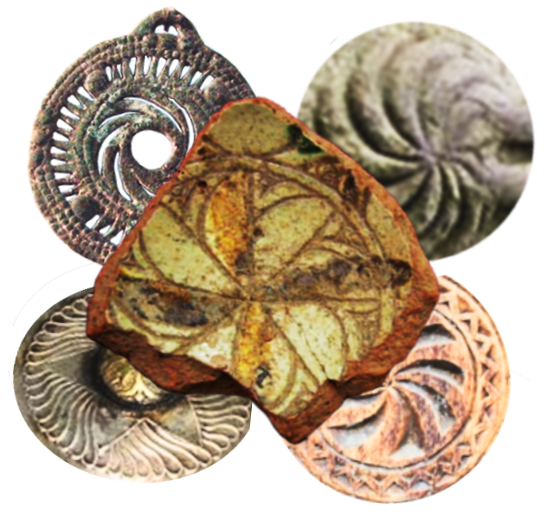შუა საუკუნეების ქართული მოჭიქული კერამიკა: დიალოგი ორნამენტული მოტივების მეშვეობით

ქუთაისის სახელმწიფო ისტორიულ მუზეუმში დაცულია შუა საუკუნეების მოჭიქული კერამიკული ჭურჭლის ორნამენტირებული ფრაგმენტები, რომლებიც ძირითადად, ძველი ნაქალაქარის არქეოლოგიური კვლევების შედეგად იქნა აღმოჩენილი. არტეფაქტების უმეტესი ნაწილი მცენარეული, ზოომორფული, აბსტრაქტული და სხვ. ორნამენტული მოტივებითაა შემკული. წინამდებარე ნაშრომში კვლევის მიზანს წარმოადგენს ქუთაისური კოლექციის კერამიკულ ჭურჭელზე გამოსახული ასტრალურ-კოსმოგონიური ხასიათის მატარებელი სიმბოლოს – ბორჯღალისა და მბრუნავი მოტივების განხილვა, ადრეული ეპოქიდან მისი გამოვლინების, მეზობელი რეგიონების კერამიკის ორნამენტიკასთან შედარების და სხვა ძეგლებზე (მონუმენტური და მინიატურული მხატვრობა, ქვის რელიეფები, ჭედური ხატები, ქსოვილები) ანალოგების ძიებისა და პარალელების ანალიზის გზით. საკითხის კვლევისათვის გამოყენებულ იქნა მეთოდები: მხატვრული სტილის, პალიტრისა და კომპოზიციის ვიზუალური ანალიზი; ისტორიული და კულტურული ანალიზი სხვა არქეოლოგიურ აღმოჩენებთან ურთიერთკავშირის დადგენისათვის; საქართველოსა და უცხო ქვეყნების კოლექციების ნიმუშებთან შედარებითი ანალიზი და ანალოგიების ძიება. კვლევის შედეგად გამოვლინდა, რომ ბორჯღალს ძველთაგანვე იყო მნიშვნელოვანი აპოტროპეული სიმბოლო ქართულ კულტურაში, ის მზის ხატებად მიიჩნეოდა და სხვადასხვა ფორმით გამოხატული, ერთმანეთისგან განსხვავებულ მასალებში ჰპოვებდა ასახვას. ეს სიმბოლო ქართულ რეალობაში იმდენად მყარად დამკვიდრდა, რომ თანამედროვე ეტაპზეც არ დაუკარგავს აქტუალობა. უცხოური ანალოგიური მასალების მოძიებამ გამოავლინა ადგილობრივი ორნამენტის ხასიათისა და დეკორატიული სქემების ყირიმის, მცირე აზიისა და აღმოსავლურ (სამარყანდი, ქაშანი, ნიშაბური) კერამიკასთან მსგავსება. რაც უდავოდ ადასტურებს, რომ საქართველოს კერამიკული ხელოსნობა იზოლირებულად და კარჩაკეტილად როდი ვითარდებოდა, პირიქით, იგრძნობოდა კულტურათაშორისი ზეგავლენებიც და აღმოსავლეთის, დასავლეთისა და ჩრდილოეთის ქვეყნების კერამიკის საწარმოო ცენტრებთან კავშირიც. კვლევის შედეგები ხელს უწყობს საქართველოს ისტორიულ-კულტურული კონტექსტისა და მხატვრული მემკვიდრეობის უფრო ღრმად გააზრებას.
Downloads
Metrics
No metrics found.
ბალახაშვილი ვ. (2016). ბორჯომის მხარეთმცოდნეობის მუზეუმი. ონლაინ არქეოლოგია N10. თბილისი: საქართველოს კულტურული მემკვიდრეობის დაცვის სააგენტო.
ბურუსი https://burusi.wordpress.com/2010/03/21/swastika/
თევზაია, მ. (2009). ქართული ორნამენტი. წიგნი II, თბილისი.
კერამიკული ნაკეთობანი შუა საუკუნეების საქართველოში (2013). რედაქტორი: დავით ლორთქიფანიძე ISBN: 9789941157820 სულაკაურის გამომცემლობა.
კულტურული მემკვიდრეობა აფხაზეთში (2015). თბილისი, „მერიდიანი“
მინდორაშვილი დ. (2010). კვეტერის ციხის არქეოლოგიური მასალა, თბილისი
მიწიშვილი მ. (1979) მოჭიქული კერამიკის საწარმო შუა საუკუნეების თბილისში (IX-XIII სს), თბილისი.
ნარიმანიშვილი გ. (2020). არმაზციხის კომპლექსის 2019 წლის არქეოლოგიური კვლევის მოკლე ანგარიში. 2019 წელს ჩატარებული არქეოლოგიური გათხრების მოკლე ანგარიშების კრებული. საქართველოს კულტურული მემკვიდრეობის დაცვის ეროვნული სააგენტო.
ორნამენტი ხეზე. ხელოვნების სახლი არაბული. (2014) https://www.facebook.com/photo/?fbid=644915572223552&set=a.620492157999227
ოშკი (2012). https://gelino.wordpress.com/2012/07/06/%e1%83%9d%e1%83%a8%e1%83%99%e1%83%98-2/
რკონის მონასტერი (2020) https://georgiantravelguide.com/ka/rkonis-monasteri
სადრაძე ვ. (1989). წეროვანი II. ბრინჯაო - რკინის ხანის სამაროვანი, კატალოგი. მცხეთა. არქეოლოგიური კვლევა - ძიების შედეგები. ტ. IX.
სარავა ნ., ქარციძე ნ., უგრეხელიძე ი. (2024). ქუთაისური მოჭიქული კერამიკული ჯამის ორნამენტის შესწავლისათვის. თბილისის სამხატვრო აკადემიის საერთაშორისო სამეცნიერო კონფერენციის მასალები. თბილისი: აკადემია, [ბეჭდვაში].
სვასტიკა..https://ka.wikipedia.org/wiki/%E1%83%A4%E1%83%90%E1%83%98%E1%83%9A%E1%83%98:Qarsvastika2.jpg
ქართული ორნამენტი (2014). https://www.facebook.com/609908925786373/photos/a.609910092452923/609910012452931/?type=3
ქართული ხუროთმოძღვრული ორნამენტი (1954). ტექსტი მასალის შერჩევა და ნახატები რენე შმერლინგისა.
ქარციძე ნ., უგრეხელიძე ი., სარავა ნ., სულაბერიძე დ. (2024). ქუთაისური მოჭიქული კერამიკის ორნამენტული მოტივები. ქუთაისი.
ქარციძე, ნ. (2010). შუა საუკუნეების მოჭიქული კერამიკა ქუთაისიდან. სადოქტორო დისერტაცია. ქუთაისი.
ქვემო ნიჩბისის ეკლესია https://georgiantravelguide.com/ka/kvemo-nichbisis-tsminda-nikolozis-eklesia
ქსოვილის ორნამენტი აჭარიდან (2021). თბილისი https://crafts.ge/assist/images/IFkktTHaQM0COeaCjsy8Eyu4ZVu08U.pdf
შუა საუკუნის ხელოვნება: ვერცხლის თასი საქართველოს ეროვნული მუზეუმი.
ჩე ოხვამე (თეთრი სალოცავი) გალის რაიონის სოფელ თაგილონში, რომელსაც აფხაზებმა სახელი გადაარქვეს და თაგლანი უწოდეს. (2019). https://intermedia.ge/%E1%83%A1%E1%83%A2%E1%83%90%E1%83%A2%E1%83%98%E1%83%90/121653
ჩუბინაშვილი, გ. (2007). არმაზის პიტიახშთა ნეკროპოლში აღმოჩენილი ნივთების მხატვრული დახასიათების ცდა თბილისი: ნეკერი.
ჩხვიმიანი ჯ. (2020). შუა საუკუნეების ქალაქ დმანისის მოსახლეობის სოციალური, ეთნიკური და კონფესიური სტრუქტურის საკითხები (ისტორიულ-არქეოლოგიური გამოკვლევა) სადოქტორო დისერტაცია ილიას სახელმწიფო უნივერსიტეტი თბილისი.
ჭილაშვილი ლ. (1970) ქალაქები ფეოდალურ საქართველოში, II, თბილისი.
ხარშილაძე გ. (2020) ქვემო ნიჩბისის წმინდა ნიკოლოზის ეკლესია
Bowl 9th century or 10th century https://collections.vam.ac.uk/item/O85386/bowl-unknown/
Bowl N1613029553 https://www.britishmuseum.org/collection/image/1613029553
Ceramic Bowl 8th - 9th Century https://www.ebay.com.my/itm/133645439883
Concordia Sagittaria - Bowl, https://www.pinterest.co.kr/pin/467600373814617781/
Coupe à décor rayonnant 1215 Lieu de provenance : Kashan (Monde iranien - Caucase->Iran) https://collections.louvre.fr/ark:/53355/cl010321170
Islamic Art. Bowl-10th century https://www.metmuseum.org/art/collection/search/449549?pos=2
Kartsidze N. G., Ugrekhelidze I. I., Sarava N. D., Sulaberidze D. N. (2024). Glazed ceramic vessel with the image of a bird from the Kutaisi Historical Museum. Global science: prospects and innovations. Proceedings of the 7th International scientific and practical conference. Liverpool, United Kingdom.: Cognum Publishing House, pp. 414-420. URL: https://sci-conf.com.ua/vii-mizhnaro dna-naukovo-praktichna-konferentsiya-global-science-prospects-and-innovations-1-3-03-2024-liverpul-velikobritaniya-arhiv/
Kartsidze N. G., Ugrekhelidze I. I., Sarava N. D., Sulaberidze D. N. (2024). For the Decoration of Kutaisi Glazed Ceramics // Modern research in science and education. Proceedings of the 7th International scientific and practical conference. Chicago, USA: BoScience Publishe,. pp. 342-349. URL: https://sci-conf.com.ua/vii-mizhnarodna-naukovo-prak tichna-konferentsiya-mo dern-research-in-scien ce-and-education-7-9-03-2024-chikago-ssha-arhiv/.
Kartsidze, N., Lanchava, O., Ugrekhelidze, I., Sulaberidze, D., Sarava, N. (2023). Artifacts Reflecting the Traditions of Producing Glazed Ceramics from the Kutaisi Historical Museum. Proceedings of Georgian National Academy of Sciences, series of History, Archaeology, Ethnology and Art History, no. 2, pp. 128-138. http://macne.org.ge /index.php/macne/article/view/113
Lane, Arthur. Early Islamic Pottery. London: Faber and Faber, 1947. 52p., ill. Page 18, plate 21A.
Niszapur Miska ceramiczna https://www.catawiki.com/pl/l/81414253-niszapur-miska-ceramiczna
Porter Y. (2012). Le prince, l'artiste et l'alchimiste : La céramique dans le monde iranien Xe-XVIIIe siècle. Paris, Hermann, 2011. Bulletin critique des Annales islamologiques N27.
Sedikova. L. (2011). Glazed Ware from the Mid Tirteenth-Century Destruction Layer of Chersonesos. Medieval and Post-Medieval Ceramics in the Eastern Mediterranean - Fact and Fiction. Proceedings of the First International Conferenceon Byzantine and Ottoman Archaeology. Amsterdam.
Ugrekhelidze I.I., Kartsidze N.G., Sarava N.D., Sulaberidze D.N. (2024). Glazed Ceramics with Epigraphical Ornament from Kutaisi Historical Museum. Золотоордынское обозрение [in print].
Waksman, S. Y. (2014). Long-term pottery production and chemical reference groups: examples from Medieval Western Turkey. In: Meyza, H. (ed.), Late Hellenistic to Mediaeval Fine wares of the Aegean Coast of Anatolia. Their production, imitation and use. Warsaw: Neriton, p. 107—125.
Wilkinson, Charles K. Nishapur: Pottery of the Early Islamic Period. New York: The Metropolitan Museum of Art, 1973. no. 53, ch. 4, pp. 144, 156, ill. p. 156 (b/w).
Yangaki A. (2017). Immured vessels in the church of Panagia Eleousa, Kitharida, Crete. Поливная керамика Средиземноморья и Причерноморья X—XVIII вв. 2.
Грузия. Орнамент https://www.pinterest.com/pin/438115870006571348/
Масловский А. Н. (2017). Восточнокрымский поливной импорт в золотоордынском Азаке. Вопросы хронологии. Поливная керамика Средиземноморья и Причерноморья X—XVIII вв. 2.
Особенности посещения монастыря Ркони tourist guide and agency Viva-Georgia https://v-georgia.com/showplaces/osobennosti-poseshheniya-monastyrya-rkoni/
Тесленко И. Б. (2017). Комплекс керамики из раскопок усадьбы золотоордынского периода в Алуште // Поливная керамика Средиземноморья и Причерноморья X—XVIII вв. 2.
Тесленко И. Б. (2021). Керамика Крыма XV века. — Киев: ИА НАН Украины, 308 c.
Хуторской А.В. (2023). Есть ли язычество в Грузии? https://dzen.ru/a/ZIJF7mCU_1XoQBha
საავტორო უფლებები (c) 2025 ქართველი მეცნიერები

ეს ნამუშევარი ლიცენზირებულია Creative Commons Attribution-NonCommercial-NoDerivatives 4.0 საერთაშორისო ლიცენზიით .





